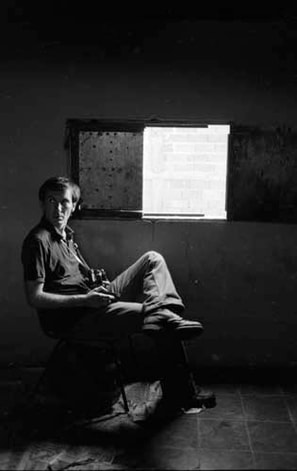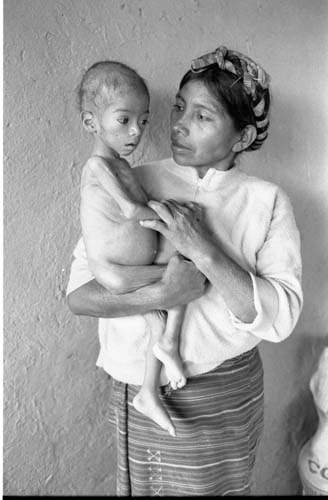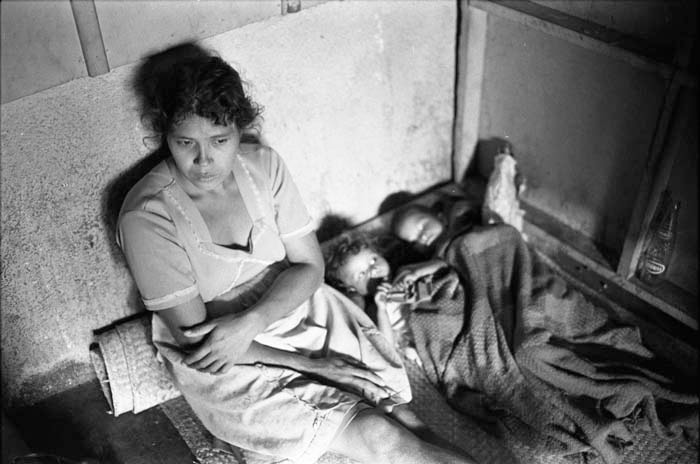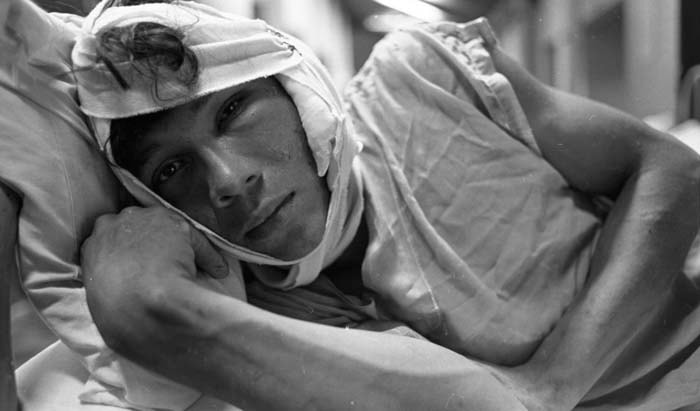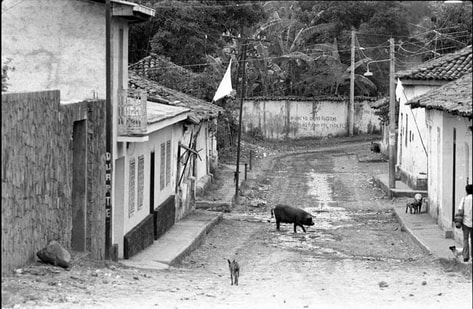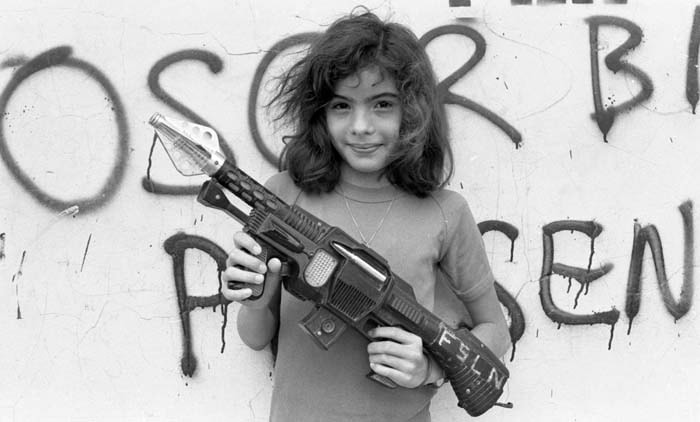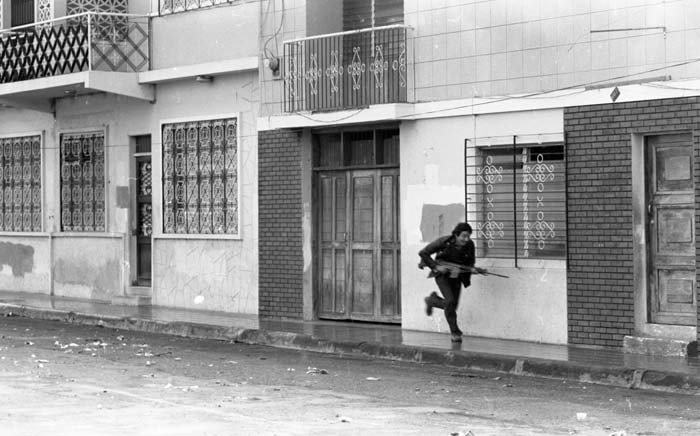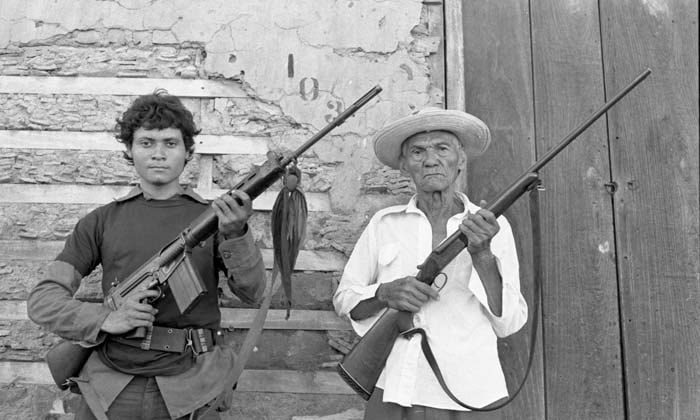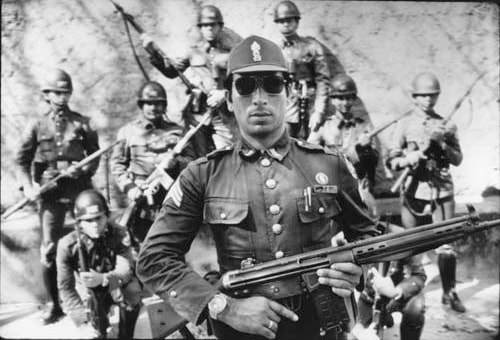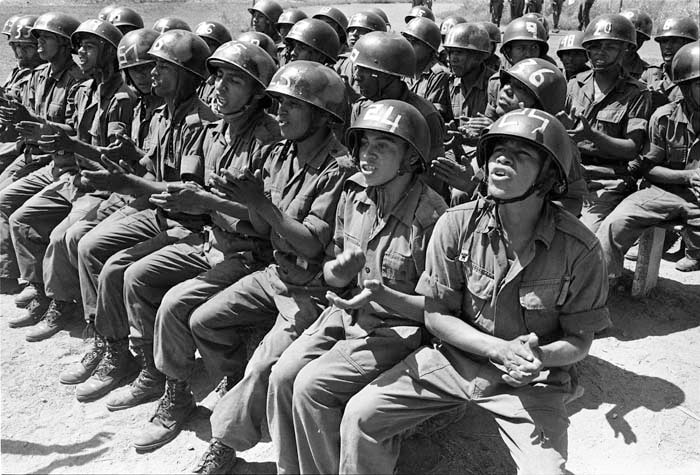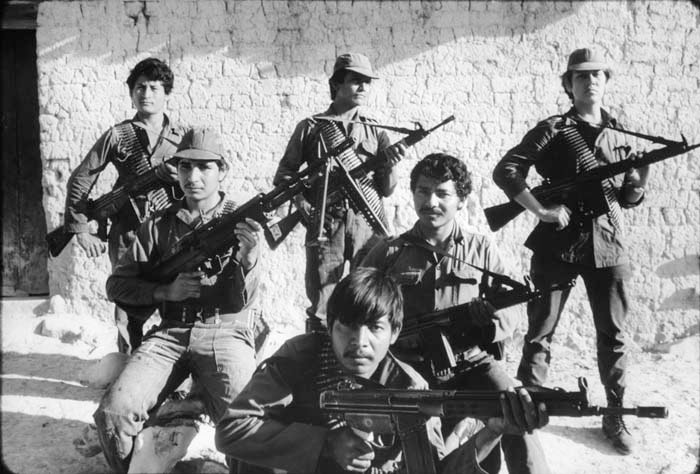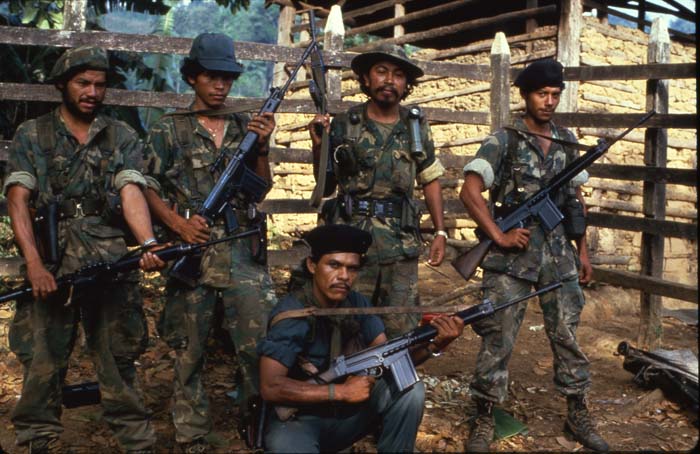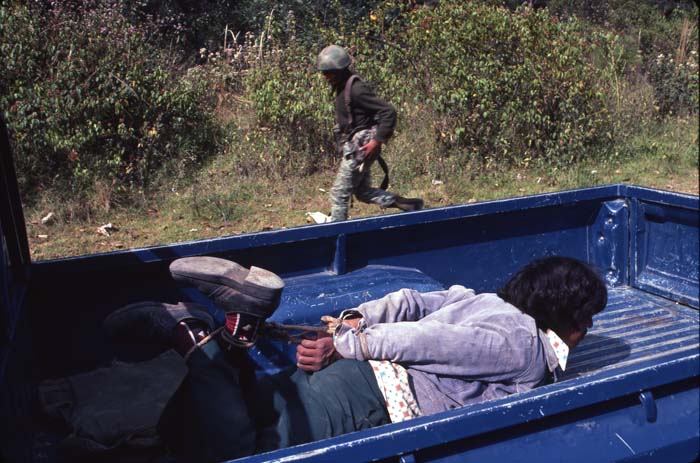VISUALIZING THE PEOPLE'S HISTORY:
RICHARD CROSS'S IMAGE OF THE CENTRAL AMERICAN LIBERATION WARS
AUGUST 15, 2019–JANUARY 12, 2020
American photojournalist Richard Cross documented the turbulent period of liberation wars in Central America from 1979 to 1983, until he was killed while on assignment in Honduras. The photographs depict communities and landscapes enduring war and genocide. Cross’s work illuminates the legacies of these wars, which propelled the largest contemporary migration of people from Central America to the United States, and which continue to shape their American experience.
EXHIBITION PHOTOGRAPHS
Richard Cross (1950–1983) was born in Kansas City, Missouri. He began his career as a photojournalist at the Daily Globe in Worthington, Minnesota. He spent four years (1974–1978) in Colombia, working as a photographer. In 1979, Cross was drawn north to document the wars raging in Nicaragua, El Salvador, Honduras, and Guatemala, as well as the refugee crisis in Southern Mexico. There, he freelanced for major news outlets including U.S. News and World Report, Newsweek, and the Associated Press, and was nominated for a Pulitzer Prize for his work in Nicaragua. A selection of 76 photos was published in a 1982 book co-authored with Nicaraguan poet Ernesto Cardenal, Nicaragua: la guerra de liberación (1982). He was killed when the car in which he was traveling ran over a land mine in Honduras on June 21, 1983, along with Los Angeles Times reporter Dial Torgerson. Cross was 33 years old.
A group of Salvadoran soldiers performing target practice at the Ilopango military base. American advisors were assigned to train and advise the El Salvadoran Armed Forces in their fight against the guerrillas. The Ilopango air base, whose pilots were mostly trained in the United States, was run by Gen. Juan Rafael Bustillo. In 2008, Bustillo was charged in Spain for planning the murder of six Jesuit priests, a housekeeper, and her daughter at the Universidad Centroamericana "José Simeón Cañas" (UCA) in El Salvador in1989, and in 2017, he was charged because of the participation of the air force at his command in El Mozote massacre, when approximately 1,000 people were executed by the Salvadoran armed forces at the hands of the Atlacatl Battalion during "Operation Rescue" in December 1981. More than half of the victims were children and adolescents. Starting in Spring 1983, the Ilopango air base became the center of C.I.A. operations to supplying to the Nicaraguan Contras arms that were paid for by cocaine smuggled into the U.S.
By 1984, 46,000 Guatemalan refugees were in southern Mexico. Between 1981 and 1983, the Guatemalan army's counterinsurgency strategy targeted the Mayan population, who were believed to be supporting the guerrilla movement. The military committed hundreds of massacres and was responsible for acts of genocide against the Mayan population, according to the report of the 1994 Guatemalan Historical Clarification Commission.
A refugee mother with two children rest on concrete floor in a Berlín home turned into a refugee camp.
A refugee woman and a sick man are inside a shelter in the refugee camp of Santiago el Vértice, Chiapas. Refugees in the camps had no resources to deal with illness such as tuberculosis, dengue, malaria or malnutrition. In November 1982, Guatemalan civil patrolmen and soldiers crossed the border to attack the camp. In January of 1983, another attack by Guatemalans left two refugees dead and destroyed the camp. After this second attack, part of the population of the refugee camp of Santiago el Vértice resettled near the border settlement of Carmen Xhan.
|
A young, injured man withbandage around his head.
|
Street scene.
|
|
A group of people, some of them armed, stand outside a church in Corinto, Morazán. On the wall of the church to the right, there is graffiti that reads,
"It is because we are a people that we are invincible.” |
A young boy spins a hoop as he walks past the debris ofBerlín's central plaza in Usulután. The town was bombed and retaken by the Salvadoran Army after a brief occupation by the guerrillas.
|
|
An armed Sandinista wearing a beret stands on a street corner holding a gun.
|
A young girl holds a toy firearm. The firearm is marked with the initials, “FSLN" (Frente Sandinista de Liberación Nacional/Sandinista National Liberation Front).
|
An armed man runs on the sidewalk of a street
Two army soldiers armed with assault rifles walk among ruins in Perquín, Morazán. The guerrillas occupied the town in October 1982. But in the first couple of weeks of February 1983, Colonel Miguel Antonio Méndez and his Belloso Battalion retook the town. The guerrillas assaulted the Belloso command post in Perquín on February 23rd, forcing Méndez and his battalion to retreat from Perquín. The Belloso Battalion was formed in 1982 with training assistance of the United States. The men were trained at Ft. Bragg, North Carolina, and the battalion was nicknamed the Gringo Battalion.
A large unidentified Contra helicopter with three passengers flies over El Porvenir Farm, located two kilometers from the Honduras-Nicaragua border. In the background, the mountains of the Nicaraguan countryside are visible. The helicopter and its crew are part of the Nicaraguan Democratic Force (Fuerza Democrática Nicaragüense, FDN in Spanish), whose members were informally known as “Contras."
|
Two girls were found in area occupied earlier by guerrillas, near San Isidro, 44 miles northeast from San Salvador, El Salvador. The girls are shown smiling in a helicopter with two soldiers, ready to be flown back to capital and put into orphanage. These girls had not eaten anything in two days. An estimated 8,000 people disappeared during El Salvador’s 1980–1992 war, including thousands of children. Many of them were separated from their parents and entrusted to corrupt adoption agencies that placed children in homes in other countries.
|
A destroyed bridge on a country road in the department of Usulután. In the background, peasants can be seen already on the other side of the bridge relocating to a safer place.
|
|
An old veteran of the first Sandino war, 87-year-old Emilio Castellón, with a .410 shotgun, stands next to an 18-year old Sandinista with a FAL assault rifle.
|
A group of young men pose for a photograph holding their rifles, a guitar, and a radio.
|
|
National guardsman aiming his weapon against Sandinistas.
|
A Sandinista plays the guitar and smokes a cigarette.
|
|
An officer of the Salvadoran National Guard with his rifle. His soldiers stand in the background also holding their arms.
|
.Three Salvadoran Army soldiers stand guard with their rifles outside of an army base in Perquín, Morazán. They are members of the Ramón Belloso Battalion, which received special training at Fort Bragg, North Carolina, U.S.
|
|
Salvadoran soldiers sit on benches during parachute training at the Ilopango air base, El Salvador. The air base, whose pilots were mostly trained in the United States, was run by Gen. Juan Rafael Bustillo.
|
A squad of six guerrilla members pose for a photograph holding their assault rifles.
|
In 2008, Bustillo was charged in Spain for planning the murder of six Jesuit priests, a housekeeper, and her daughter at the Universidad Centroamericana "José Simeón Cañas" (UCA) in El Salvador in 1989, and in 2017, he was charged because of the participation of the air force at his command in El Mozote massacre, when approximately 1,000 people were executed by the Salvadoran armed forces at the hands of the Atlacatl Battalion during "Operation Rescue" in December 1981. More than half of the victims were children and adolescents. Starting in Spring 1983, the Ilopango air base became the center of C.I.A. operations to supplying to the Nicaraguan Contras arms that were paid for by cocaine smuggled into the U.S.
Four children, three men and two women (one holding a baby) pose with three soldiers in front of a building in Perquín, Morazán. The guerrillas had occupied the town in October 1982. But in the first couple of weeks of February 1983, Colonel Miguel Antonio Méndez and his Belloso Battalion retook the town. The guerrillas assaulted the Belloso command post in Perquín on February 23rd forcing Méndez and his battalion to retreat from Perquín. The Belloso Battalion was formed in 1982 with training assistance of the United States. The men were trained at Ft. Bragg, North Carolina, and the battalion was nicknamed the Gringo Battalion.
|
Survival school students: Jack Madeley, Marilyn Chandler, Allen Mons, Joel Turner, Brian Schwarz, and Ron Venn. The students are U.S. civilians with different backgrounds who paid money in exchange for survivalism training. Harry Claflin, a former marine who served in Vietnam and the owner of the school, trained military personnel in Central America.
|
A Contra squad poses at El Porvenir Farm, located two kilometers from the Honduras-Nicaragua border. From left to right: Eco; Julio César Herrera, a former member of the Nicaraguan National Guard trained in Argentina and known as Commander Krill; Pedro Ortiz Centeno, a former National Guard Sergeant known as Commander Suicida; Josué; and Delta, who is crouching. They are all carrying Belgian FN FAL assault rifles. They are members of the Nicaraguan Democratic Force (FDN in Spanish), whose members were informally known as “Contras."
|
|
A hogtied man lies in the cargo bed of a pickup truck near Chichicastenango, department of El Quiché. The soldiers suspected that the man was a guerrilla. The UN-managed Truth Commission, known as the Commission of Historical Clarification documented more tan 400 massacres committed by government forces against civilians in predominately Mayan areas between 1981 and 1983.
|
A woman stands at the door. Her house has been marked witha pair of hand prints on the wall. This was the signature of Salvadoran death squads.
|
|
In March of 1982, a soldier of the Salvadoran Army from the Atlacatl Battalion holds a newspaper that reads, ""Vote Defeats Violence."" The image was taken outside of a Salvadoran Army barracks in the department of Usulután.
|
A young girl holds a bullet shell in her hands.
|
|
Men wait in a long line to vote. Groups of Mayan men started lining up to vote at five in the morning. They were told that they would be killed if they did not vote.
|
A group of women line up to receive food rationsin front of a burned out bus. The bus was burned by the guerrilla.
|
Mayan refugees wash their clothes in the river next to the refugee camp of Puerto Rico, Chiapas. In May 1984, Mexican Minister of the Interior, Manuel Bartlett Díaz, decided to relocate the approximately 46,000 Guatemalans from the state of Chiapas to the state of Campeche. The first physical resettlement of refugees began in July of 1984 in the lowland Lacandón jungle camps of Puerto Rico and Ixcán, and continued in that area through early August. The Mexican government burned down the entire Puerto Rico camp, with close to one-thousand homes, to force the refugees to relocate.
|
Two guerrilla members, a woman and a man, in La Palma are enjoying a theatrical performance organized for guerrilla for guerrilla members and residents by the Farabundo Martí Liberation People's Forces (FPL).
|
Three guerrilla women from the Farabundo Martí Liberation People's Forces (FPL) sit and watch a theatrical performance in the town of La Palma, El Salvador. Guerrillas occupied this town of 12,000 people for twenty-four hours and then retreated to the hills in the middle of the night.
|
A guerrilla man with a cigarette in his hand sits on a cot with three children, two girls and a boy, during the five-day long occupation of the town of San Agustín, Usulután, after the takeover of Berlín, El Salvador.
|

